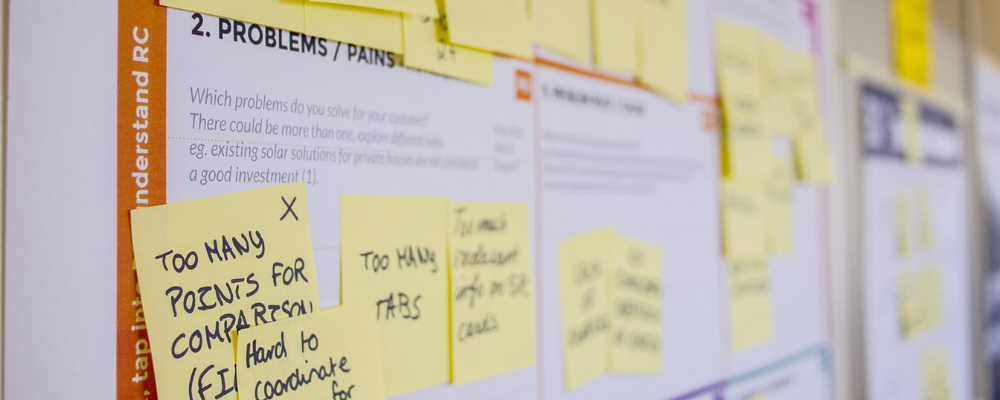UX research is a critical technique that must be implemented the right way in order to get the best results. This is why we have gathered 6 effective UX research approaches that you must try. With each method, we have briefly discussed its purpose, most effective implementation, and results.
6 UX research methods
-
Interviewing
Purpose
This high-quality UX research strategy aids UX designers in getting to know users on a personal level. It gives them the chance to collect additional insights and pain points that may not have been discovered using other, more conventional ways.
Methodology
Interviews are relatively simple to put together. Once you have identified and scheduled time with your interviewees, you can connect over the phone, over Skype, or in a face-to-face meeting. Above all, it’s important to ask open-ended questions. The use of direct or multiple-choice questions limits the users’ ability to provide the most useful information.
In order to prepare, you may need some practice. It’s also important to remain neutral and not coax answers out of your subjects, in order to ensure that your conclusions are unbiased.
Result
After conducting several interviews, you should have enough qualitative data to identify a product focus. After you’ve identified the primary issues to address, conduct more in-depth interviews to learn more about those issues, as well as other pain points in your product’s user experience.
-
Field UX research
Purpose
Another approach is field UX research. This method investigates consumers in their own environment and discovers difficulties as well as their own answers during real-life usage.
Methodology
One of the best ways to understand how people experience your product is being in the mix with them, as they use it. Spend time with them, stand behind them, and watch what they do in silence. Ask questions after to have a better understanding of why they do what they do. You can conduct field research in call centers for management software, in an airport for a booking app, and in hospitals for physiotherapists’ new apps, to name a few examples.
Result
Through this form of UX research, you will uncover usability issues as well as suggestions for how to remedy them. It illustrates the process and pain areas in the context they will be used in, resulting in better solutions.
-
Diary UX research
Purpose
A diary study is a user experience research method that gathers consumers’ personal insights and experiences while they are going through a complicated process. You have people write journals about their experiences, which you then examine in order to obtain insights.
Methodology
You can use this strategy with multiple people remotely. During the process, have them write down their feelings/problems at specific points throughout the day. Give them a framework and certain questions to answer in order to complete their journal, or leave it up to them to conduct an open-ended search.
Result
This is excellent for mapping the customer journey for complex processes and buying decisions, such as applying for a loan or renovating your home. It also shows how consumers adopt and overcome problems in their own unique way.
-
Internet research
Purpose
Product discovery is a breeze with online research. People’s problems and information about them are abound on the internet. All you need is to search for them and then analyze them. It takes some effort and patience, and it’s a time-consuming task, but it yields excellent results.
Methodology
Begin by identifying your target demographic and conducting a few Google searches to locate online communities. From there, learn about the pains that people are discussing. Make sure the communities you are gleaning information from are active and providing recent data you can use.
Result
Gather a large amount of knowledge about a topic quickly and identify current pain areas that a product idea can address.
-
Usability testing
Purpose
Start testing ideas once you have a clickable prototype or even some rough sketches. Many usability concerns will be revealed through usability tests: what do the users understand and what don’t they quite get? Where do they become tangled up? We give our test participants certain tasks to complete using our product during a usability test and then monitor how they do.
Methodology
To begin, gather test subjects from your target demographic. You can best achieve this by having a user persona crafted. Then obtain a working prototype, a wireframe, or an app or website that is already up and running. Prepare the tasks that the participants will do ahead of time. Then find a platform or means to conducted the test, either remotely or in person.
Result
User testing reveals what new users do and don’t comprehend, as well as what misleads them. Individual activities can be tested, but entire processes can also be tested.
Read More: Moderated vs. unmoderated website usability testing
-
Multivariate or A/B testing
Purpose
The A/B test is quite beneficial since it demonstrates which option performs better in a real-world setting. Use it to come up with fresh design or feature ideas for an existing website.
Methodology
Determine what to measure and how to identify the winning approach ahead of time. In an A/B test, run two versions at the same time, or many more in multivariate testing. If you’re doing a simple A/B test with two variants, make sure to keep the difference between them fairly simple. More disparities will make it difficult to pinpoint the reason for the winner’s superior performance.
Result
The output from A/B testing should determine which solution performs better objectively. They simply will not show why. Adding in qualitative research, on the other hand, will.
Conclusion
This was a short guide to 6 different UX research approaches along with their brief details. Hopefully, now you are well aware of when to use each particular approach, how to best implement it, and the results that you’ll gain after. For any firm questions feel free to drop down your queries in the comments section below.





